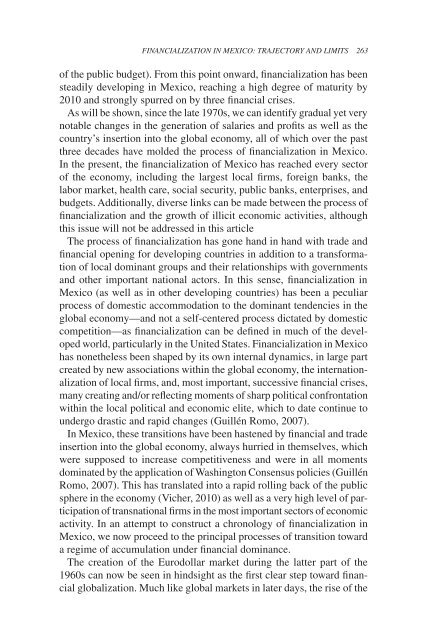Financialization in Mexico - Dr. Gregorio Vidal
Financialization in Mexico - Dr. Gregorio Vidal
Financialization in Mexico - Dr. Gregorio Vidal
You also want an ePaper? Increase the reach of your titles
YUMPU automatically turns print PDFs into web optimized ePapers that Google loves.
FINANCIALIzATION IN MEXICO: TRAJECTORY AND LIMITS 263<br />
of the public budget). From this po<strong>in</strong>t onward, f<strong>in</strong>ancialization has been<br />
steadily develop<strong>in</strong>g <strong>in</strong> <strong>Mexico</strong>, reach<strong>in</strong>g a high degree of maturity by<br />
2010 and strongly spurred on by three f<strong>in</strong>ancial crises.<br />
As will be shown, s<strong>in</strong>ce the late 1970s, we can identify gradual yet very<br />
notable changes <strong>in</strong> the generation of salaries and profits as well as the<br />
country’s <strong>in</strong>sertion <strong>in</strong>to the global economy, all of which over the past<br />
three decades have molded the process of f<strong>in</strong>ancialization <strong>in</strong> <strong>Mexico</strong>.<br />
In the present, the f<strong>in</strong>ancialization of <strong>Mexico</strong> has reached every sector<br />
of the economy, <strong>in</strong>clud<strong>in</strong>g the largest local firms, foreign banks, the<br />
labor market, health care, social security, public banks, enterprises, and<br />
budgets. Additionally, diverse l<strong>in</strong>ks can be made between the process of<br />
f<strong>in</strong>ancialization and the growth of illicit economic activities, although<br />
this issue will not be addressed <strong>in</strong> this article<br />
The process of f<strong>in</strong>ancialization has gone hand <strong>in</strong> hand with trade and<br />
f<strong>in</strong>ancial open<strong>in</strong>g for develop<strong>in</strong>g countries <strong>in</strong> addition to a transformation<br />
of local dom<strong>in</strong>ant groups and their relationships with governments<br />
and other important national actors. In this sense, f<strong>in</strong>ancialization <strong>in</strong><br />
<strong>Mexico</strong> (as well as <strong>in</strong> other develop<strong>in</strong>g countries) has been a peculiar<br />
process of domestic accommodation to the dom<strong>in</strong>ant tendencies <strong>in</strong> the<br />
global economy—and not a self-centered process dictated by domestic<br />
competition—as f<strong>in</strong>ancialization can be def<strong>in</strong>ed <strong>in</strong> much of the developed<br />
world, particularly <strong>in</strong> the United States. <strong>F<strong>in</strong>ancialization</strong> <strong>in</strong> <strong>Mexico</strong><br />
has nonetheless been shaped by its own <strong>in</strong>ternal dynamics, <strong>in</strong> large part<br />
created by new associations with<strong>in</strong> the global economy, the <strong>in</strong>ternationalization<br />
of local firms, and, most important, successive f<strong>in</strong>ancial crises,<br />
many creat<strong>in</strong>g and/or reflect<strong>in</strong>g moments of sharp political confrontation<br />
with<strong>in</strong> the local political and economic elite, which to date cont<strong>in</strong>ue to<br />
undergo drastic and rapid changes (Guillén Romo, 2007).<br />
In <strong>Mexico</strong>, these transitions have been hastened by f<strong>in</strong>ancial and trade<br />
<strong>in</strong>sertion <strong>in</strong>to the global economy, always hurried <strong>in</strong> themselves, which<br />
were supposed to <strong>in</strong>crease competitiveness and were <strong>in</strong> all moments<br />
dom<strong>in</strong>ated by the application of Wash<strong>in</strong>gton Consensus policies (Guillén<br />
Romo, 2007). This has translated <strong>in</strong>to a rapid roll<strong>in</strong>g back of the public<br />
sphere <strong>in</strong> the economy (Vicher, 2010) as well as a very high level of participation<br />
of transnational firms <strong>in</strong> the most important sectors of economic<br />
activity. In an attempt to construct a chronology of f<strong>in</strong>ancialization <strong>in</strong><br />
<strong>Mexico</strong>, we now proceed to the pr<strong>in</strong>cipal processes of transition toward<br />
a regime of accumulation under f<strong>in</strong>ancial dom<strong>in</strong>ance.<br />
The creation of the Eurodollar market dur<strong>in</strong>g the latter part of the<br />
1960s can now be seen <strong>in</strong> h<strong>in</strong>dsight as the first clear step toward f<strong>in</strong>ancial<br />
globalization. Much like global markets <strong>in</strong> later days, the rise of the


